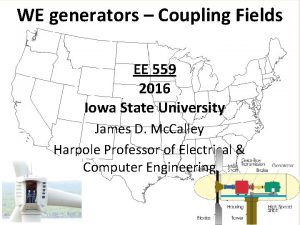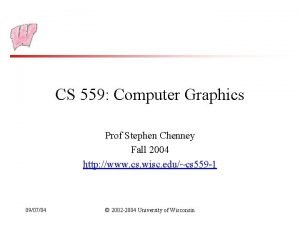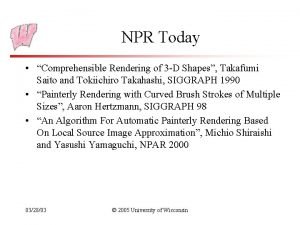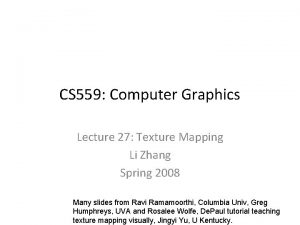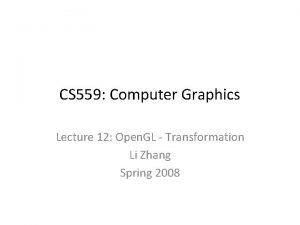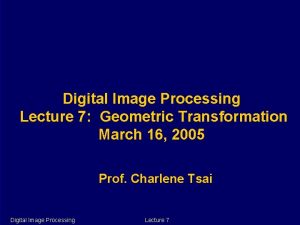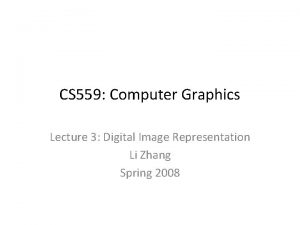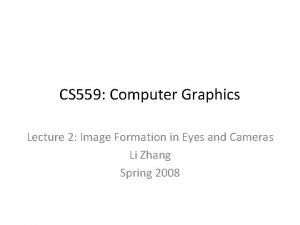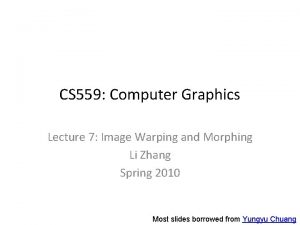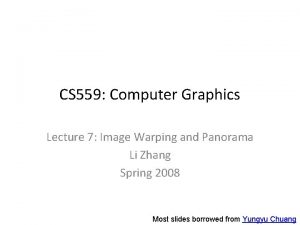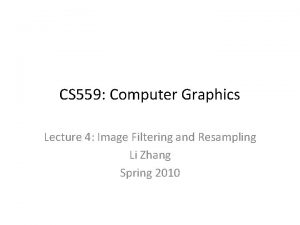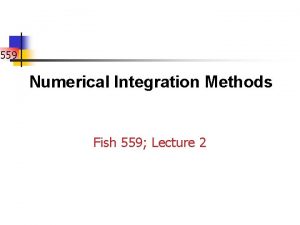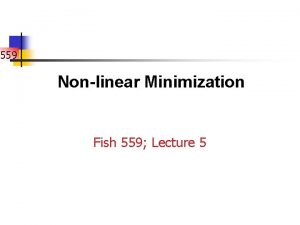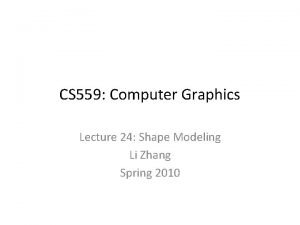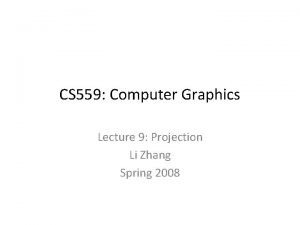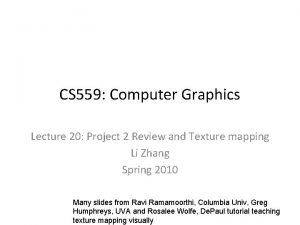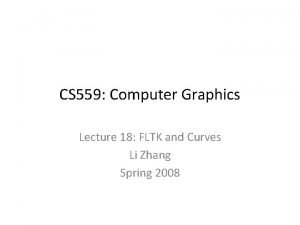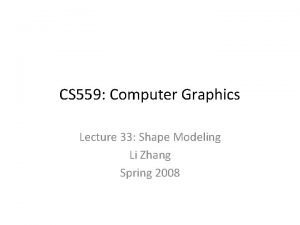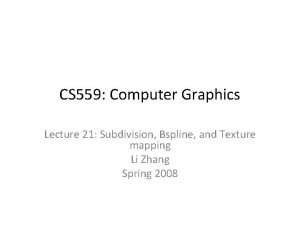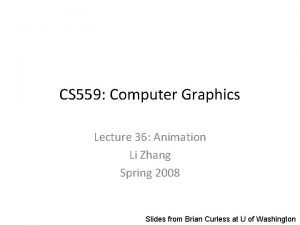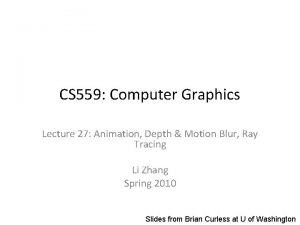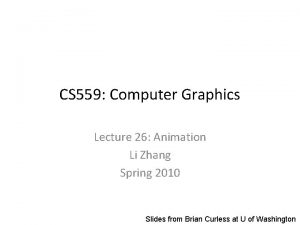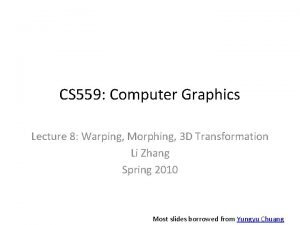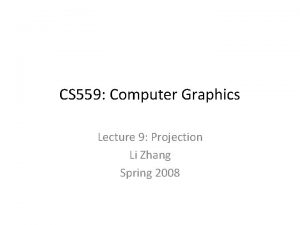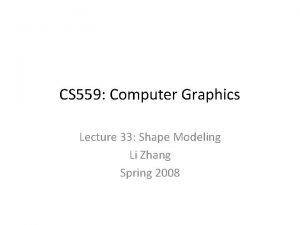CS 559 Computer Graphics Lecture 3 Digital Image































- Slides: 31

CS 559: Computer Graphics Lecture 3: Digital Image Representation Li Zhang Spring 2008

Today • Eyes • Cameras

Image as a discreet function Represented by a matrix

Convolution 0 0 0. 5 0 0 I

What is image filtering? • Modify the pixels in an image based on some function of a local neighborhood of the pixels. 10 5 3 4 5 1 1 1 7 Local image data Some function 7 Modified image data

Linear functions • Simplest: linear filtering. – Replace each pixel by a linear combination of its neighbors. • The prescription for the linear combination is the “convolution kernel”. 10 5 3 0 4 5 1 0 0. 5 0 1 1 7 0 Local image data 0 0 7 1 0. 5 kernel Modified image data

coefficient Linear filtering (warm-up slide) 1. 0 0 original Pixel offset ?

coefficient Linear filtering (warm-up slide) 1. 0 0 original Pixel offset Filtered (no change)

Linear filtering coefficient 1. 0 0 Pixel offset original ?

shift coefficient 1. 0 0 Pixel offset original shifted

coefficient Linear filtering 0. 3 0 Pixel offset original ?

coefficient Blurring 0. 3 0 Pixel offset original Blurred (filter applied in both dimensions).

8 impulse original coefficient Blur Examples 2. 4 0. 3 0 Pixel offset filtered

Blur Examples impulse filtered 4 coefficient Pixel offset 8 original 0. 3 0 original edge 2. 4 coefficient 8 8 4 0. 3 0 Pixel offset filtered

Linear filtering (warm-up slide) 2. 0 1. 0 0 original 0 ?

Linear Filtering (no change) 2. 0 1. 0 0 original 0 Filtered (no change)

Linear Filtering 2. 0 0. 33 0 original 0 ?

coefficient (remember blurring) 0. 3 0 Pixel offset original Blurred (filter applied in both dimensions).

Sharpening 2. 0 0. 33 0 original 0 Sharpened original

Sharpening example 8 original 11. 2 8 coefficient 1. 7 -0. 3 -0. 25 Sharpened (differences are accentuated; constant areas are left untouched).

Sharpening before after

Noise • Image processing is also useful for noise reduction and edge enhancement. We will focus on these applications for the remainder of the lecture… • Common types of noise: – Salt and pepper noise: contains random occurrences of black and white pixels – Impulse noise: contains random occurrences of white pixels – Gaussian noise: variations in intensity drawn from a Gaussian normal distribution

Ideal noise reduction

Ideal noise reduction

Practical noise reduction • How can we “smooth” away noise in a single image? • Is there a more abstract way to represent this sort of operation? Of course there is!

Mean filters • How can we represent our noise-reducing averaging filter as a convolution diagram (know as a mean filter)?

Effect of mean filters

Gaussian filters • Gaussian filters weigh pixels based on their distance from the center of the convolution filter. In particular: • This does a decent job of blurring noise while preserving features of the image. • What parameter controls the width of the Gaussian? • What happens to the image as the Gaussian filter kernel gets wider? • What is the constant C? What should we set it to?

Effect of Gaussian filters

Median filters • A median filter operates over an mxm region by selecting the median intensity in the region. • What advantage does a median filter have over a mean filter? • Is a median filter a kind of convolution?

Effect of median filters
 Graphics monitors and workstations in computer graphics
Graphics monitors and workstations in computer graphics Graphics hardware in computer graphics ppt
Graphics hardware in computer graphics ppt Ee 559
Ee 559 Cs 559
Cs 559 Cs 559 uw madison
Cs 559 uw madison Redbook 559
Redbook 559 G&l
G&l Image transform in digital image processing
Image transform in digital image processing Linear position invariant degradation
Linear position invariant degradation Spatial and temporal redundancy in digital image processing
Spatial and temporal redundancy in digital image processing Key stage in digital image processing
Key stage in digital image processing Analog image and digital image
Analog image and digital image Objective fidelity criteria
Objective fidelity criteria Image sharpening in digital image processing
Image sharpening in digital image processing Image geometry in digital image processing
Image geometry in digital image processing False contouring
False contouring Image transform in digital image processing
Image transform in digital image processing Maketform matlab
Maketform matlab Image restoration in digital image processing
Image restoration in digital image processing 01:640:244 lecture notes - lecture 15: plat, idah, farad
01:640:244 lecture notes - lecture 15: plat, idah, farad Image processing lecture notes
Image processing lecture notes Image processing lecture
Image processing lecture Digital graphics and animation
Digital graphics and animation The purpose of digital graphics
The purpose of digital graphics Investigating digital graphics
Investigating digital graphics Computer security 161 cryptocurrency lecture
Computer security 161 cryptocurrency lecture Computer aided drug design lecture notes
Computer aided drug design lecture notes Architecture lecture notes
Architecture lecture notes Computer architecture lecture
Computer architecture lecture Angel computer graphics
Angel computer graphics Projection in computer graphics
Projection in computer graphics Display devices in computer
Display devices in computer


